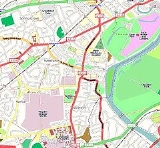
Isleworth
Encyclopedia

Anglo-Saxons
Anglo-Saxon is a term used by historians to designate the Germanic tribes who invaded and settled the south and east of Great Britain beginning in the early 5th century AD, and the period from their creation of the English nation to the Norman conquest. The Anglo-Saxon Era denotes the period of...
origin sited within the London Borough of Hounslow
London Borough of Hounslow
-Political composition:Since the borough was formed it has been controlled by the Labour Party on all but two occasions. In 1968 the Conservatives formed a majority for the first and last time to date until they lost control to Labour in 1971. Labour subsequently lost control of the council in the...
in west London
London
London is the capital city of :England and the :United Kingdom, the largest metropolitan area in the United Kingdom, and the largest urban zone in the European Union by most measures. Located on the River Thames, London has been a major settlement for two millennia, its history going back to its...
, England. It lies immediately east of the town of Hounslow and west of the River Thames
River Thames
The River Thames flows through southern England. It is the longest river entirely in England and the second longest in the United Kingdom. While it is best known because its lower reaches flow through central London, the river flows alongside several other towns and cities, including Oxford,...
and its tributary the River Crane
River Crane, London
The River Crane is a river in west London, England, and is a tributary of the River Thames.-Location:The River Crane is 8.5 miles in length...
. Isleworth's original area of settlement, alongside the Thames, is known as 'Old Isleworth'. The north-west corner of the town, bordering on Osterley
Osterley
Osterley is a district in the London Borough of Hounslow in west London. It is situated approximately west south-west of Charing Cross.Osterley lies north of the A4 and extends further northwards beyond the M4 Motorway...
to the north and Lampton to the west, is known as 'Spring Grove'.
Isleworth's former Thames frontage of approximately one mile, excluding that of the Syon estate, was reduced to little over half a mile in 1994 when a borough boundary realignment was effected in order to unite the district of St Margarets wholly within London Borough of Richmond upon Thames
London Borough of Richmond upon Thames
The London Borough of Richmond upon Thames is a London borough in South West London, UK, which forms part of Outer London. It is unique because it is the only London borough situated both north and south of the River Thames.-Settlement:...
. As a result, Isleworth's boundary with the Thames is now almost entirely overshadowed by the 3.5 hectares (8.6 acre) islet of Isleworth Ait
Isleworth Ait
Isleworth Ait, is a teardrop shaped island in the River Thames in England. It is on the Tideway near Isleworth in the London Borough of Hounslow, and is one of the longest aits. It lies offshore from Heron's Place, and is opposite the "London Apprentice" public house.Isleworth Ait is covered by...
. The River Crane flows into the Thames south of the Ait, and its distributary
Distributary
A distributary, or a distributary channel, is a stream that branches off and flows away from a main stream channel. They are a common feature of river deltas. The phenomenon is known as river bifurcation. The opposite of a distributary is a tributary...
the Duke of Northumberland's River
Duke of Northumberland's River
The Duke of Northumberland's River consists of two sections of artificial waterway. The older name: "Isleworth Mill Stream", or River, more accurately describes the economic motivation for their construction.-The western section :...
west of the Ait.
Etymology
695 Gislheresuuyrth. From an Anglo-SaxonAnglo-Saxon
Anglo-Saxon may refer to:* Anglo-Saxons, a group that invaded Britain** Old English, their language** Anglo-Saxon England, their history, one of various ships* White Anglo-Saxon Protestant, an ethnicity* Anglo-Saxon economy, modern macroeconomic term...
charter
Charter
A charter is the grant of authority or rights, stating that the granter formally recognizes the prerogative of the recipient to exercise the rights specified...
.
1086 Gistelesworde. The Domesday Survey
1301 Istelworth. Roll.
1415 Ystelworth. Roll.
Yhistelforth. George James Aungier, in 'History of Syon Monastery,
the Parish of Isleworth and the Chapelry of Hounslow, 1840.
Islleworth. Ditto
1540 Istyllworth. Local document
Istelworthe. An assize document in the reign of Elizabeth I
1554 Thyslyworth. Plea Roll, Court of Common Pleas.
1593 Thistleworth or Gistelesworth. Norden and Lysons, historians.
1702 Istleworth. Shown on a memorial in the parish church.
1742 Isleworth. Title of an engraving by Thomas Preist.
Roman and Anglo Saxon
Excavations around the eastern end of the Syon Park estate have unearthed evidence of a Romano-British settlement. 'Gislheresuuyrth', meaning in Old EnglishOld English language
Old English or Anglo-Saxon is an early form of the English language that was spoken and written by the Anglo-Saxons and their descendants in parts of what are now England and southeastern Scotland between at least the mid-5th century and the mid-12th century...
Enclosure belonging to [a man called] Gīslhere, is first referred to as a permanent settlement in an Anglo-Saxon charter in the year 695. The Domesday Book says that during the reign (1042–1066) of Edward the Confessor
Edward the Confessor
Edward the Confessor also known as St. Edward the Confessor , son of Æthelred the Unready and Emma of Normandy, was one of the last Anglo-Saxon kings of England and is usually regarded as the last king of the House of Wessex, ruling from 1042 to 1066....
the manor belonged to Earl Algar (Anglo-Saxon spelling probably Ælfgār), and a modern road off South St today carries his name.
Granted to St Valeri Barons
Isleworth was a well established riverside settlement on the MiddlesexMiddlesex
Middlesex is one of the historic counties of England and the second smallest by area. The low-lying county contained the wealthy and politically independent City of London on its southern boundary and was dominated by it from a very early time...
bank of the River Thames at the time of the Norman Conquest
Norman conquest of England
The Norman conquest of England began on 28 September 1066 with the invasion of England by William, Duke of Normandy. William became known as William the Conqueror after his victory at the Battle of Hastings on 14 October 1066, defeating King Harold II of England...
in 1066. It is recorded in the Domesday Book
Domesday Book
Domesday Book , now held at The National Archives, Kew, Richmond upon Thames in South West London, is the record of the great survey of much of England and parts of Wales completed in 1086...
(1086) as Gistelesworde. After the Conquest, successive Norman barons of the St Valeri family held the manor of Isleworth but there is no evidence that they ever lived there - it being held only as a source of revenue and power. One of the later barons gave several manorial rents and privileges to the Hospital of St Giles. He also gave the church and advowson to the Abbey of St Valeri, which stood at the mouth of the Somme
Somme
Somme is a department of France, located in the north of the country and named after the Somme river. It is part of the Picardy region of France....
in Picardy
Picardy
This article is about the historical French province. For other uses, see Picardy .Picardy is a historical province of France, in the north of France...
.
Transfer to Duchy of Cornwall

Henry III of England
Henry III was the son and successor of John as King of England, reigning for 56 years from 1216 until his death. His contemporaries knew him as Henry of Winchester. He was the first child king in England since the reign of Æthelred the Unready...
seized Isleworth and other property of the St Valeri family and gave the manor to his brother, Richard, 1st Earl of Cornwall
Richard, 1st Earl of Cornwall
Richard of Cornwall was Count of Poitou , 1st Earl of Cornwall and German King...
. He built a new moated manor house, which is described in the Black Book of the Exchequer - having a tiled roof, chimney, two bedchambers, and an inner courtyard. Beyond the moat was an outer courtyard with a number of buildings for servants and supplies, and a short distance away was a watermill. The exact location of this house is not recorded, but a report of an area long ago known as 'Moated Place' puts the likely place between the Northumberland Arms and Twickenham Road, with the watermill being near Railshead, on the River Crane (not where the traditional Isleworth mill 'Kidd's Mill' was sited, because the stream there is artificial and did not exist at that time). The seemingly classic mediæval manor house was burned down during the Second Barons' War
Second Barons' War
The Second Barons' War was a civil war in England between the forces of a number of barons led by Simon de Montfort, against the Royalist forces led by Prince Edward , in the name of Henry III.-Causes:...
in 1264.
Advowson of Isleworth Church
The Abbey of St Valeri in Picardy held the livings and revenues of several English parishes and, responding to growing disquiet over these foreign holdings, in 1391 it transferred those of Isleworth (for a fee) to William of Wykeham, who endowed them to Winchester CollegeWinchester College
Winchester College is an independent school for boys in the British public school tradition, situated in Winchester, Hampshire, the former capital of England. It has existed in its present location for over 600 years and claims the longest unbroken history of any school in England...
, which he founded. The Wardens and Scholars of Winchester College therefore became proprietors of Isleworth Church. This lasted for 150 years, then in 1543 King Henry VIII
Henry VIII of England
Henry VIII was King of England from 21 April 1509 until his death. He was Lord, and later King, of Ireland, as well as continuing the nominal claim by the English monarchs to the Kingdom of France...
exchanged with Winchester certain manors elsewhere for five churches in Middlesex, including All Saints. Four years later he gave the Isleworth rectory and advowson to the Edward Seymour, 1st Duke of Somerset
Edward Seymour, 1st Duke of Somerset
Edward Seymour, 1st Duke of Somerset, 1st Earl of Hertford, 1st Viscount Beauchamp of Hache, KG, Earl Marshal was Lord Protector of England in the period between the death of Henry VIII in 1547 and his own indictment in 1549....
, but got them back again when the Duke was executed in 1552. Soon after, they were given to the Dean
Dean (religion)
A dean, in a church context, is a cleric holding certain positions of authority within a religious hierarchy. The title is used mainly in the Anglican Communion and the Roman Catholic Church.-Anglican Communion:...
and Canons
Canon (priest)
A canon is a priest or minister who is a member of certain bodies of the Christian clergy subject to an ecclesiastical rule ....
of St George's Chapel, Windsor, with whom they remain today.
Transfer of Manor to Syon Monastery
In 1415 Henry VHenry V of England
Henry V was King of England from 1413 until his death at the age of 35 in 1422. He was the second monarch belonging to the House of Lancaster....
granted nuns from the Swedish Bridgettine order
Bridgettines
The Bridgettine or Birgittine Order is a monastic religious order of Augustinian nuns, Religious Sisters and monks founded by Saint Birgitta of Sweden in approximately 1350, and approved by Pope Urban V in 1370...
land on the bank of the Thames, in Twickenham parish opposite his new Sheen Palace
Richmond Palace
Richmond Palace was a Thameside royal residence on the right bank of the river, upstream of the Palace of Westminster, to which it lay 9 miles SW of as the crow flies. It it was erected c. 1501 within the royal manor of Sheen, by Henry VII of England, formerly known by his title Earl of Richmond,...
, where they built their first house Syon Monastery. In 1422 Henry V transferred ownership of Isleworth Manor from the Duchy of Cornwall
Duchy of Cornwall
The Duchy of Cornwall is one of two royal duchies in England, the other being the Duchy of Lancaster. The eldest son of the reigning British monarch inherits the duchy and title of Duke of Cornwall at the time of his birth, or of his parent's succession to the throne. If the monarch has no son, the...
to Syon Monastery, which in 1431 selected a new location within their manor to rebuild their monastery. This is the site of the present Syon House
Syon House
Syon House, with its 200-acre park, is situated in west London, England. It belongs to the Duke of Northumberland and is now his family's London residence...
Granted to Duke of Somerset
Henry VIIIHenry VIII of England
Henry VIII was King of England from 21 April 1509 until his death. He was Lord, and later King, of Ireland, as well as continuing the nominal claim by the English monarchs to the Kingdom of France...
demolished most of Syon Monastery after 1539 and the site and manor was granted to Edward Seymour, 1st Duke of Somerset
Edward Seymour, 1st Duke of Somerset
Edward Seymour, 1st Duke of Somerset, 1st Earl of Hertford, 1st Viscount Beauchamp of Hache, KG, Earl Marshal was Lord Protector of England in the period between the death of Henry VIII in 1547 and his own indictment in 1549....
. It was Seymour who built Syon House
Syon House
Syon House, with its 200-acre park, is situated in west London, England. It belongs to the Duke of Northumberland and is now his family's London residence...
in 1548.
Acquired by Earl of Northumberland
Forty-six years later, in 1594 Queen Elizabeth I granted a lease of the manor of Syon to Henry Percy, 9th Earl of NorthumberlandHenry Percy, 9th Earl of Northumberland
Henry Percy, 9th Earl of Northumberland KG was an English aristocrat. He was a grandee and one of the wealthiest peers of the court of Elizabeth I. Under James I, Henry was a long-term prisoner in the Tower of London. He is known for the circles he moved in as well as for his own achievements...
on his marriage to Dorothy Devereux the younger daughter of Walter Devereux, 1st Earl of Essex
Walter Devereux, 1st Earl of Essex
Walter Devereux, 1st Earl of Essex, KG , an English nobleman and general. From 1573 until his death he fought in Ireland in connection with the Plantation of Ulster, where he ordered the massacre of Rathlin Island...
, who later received a grant of the freehold from King James I in 1604. It has remained in the possession of the Percy family, now the Dukedom of Northumberland, for over four hundred years. The Royalist army occupied the house during the Battle of Brentford
Battle of Brentford (1642)
The Battle of Brentford was a small pitched battle which took place on 12 November 1642, between a detachment of the Royalist army, under the command of Prince Rupert and two infantry regiments of Parliamentarians with some horse in support...
in November 1642. Syon Park was rebuilt and landscaped by the Adam brothers and "Capability" Brown between 1766 and 1773. It became the new London home of the Dukes of Northumberland
Duke of Northumberland
The Duke of Northumberland is a title in the peerage of Great Britain that has been created several times. Since the third creation in 1766, the title has belonged to the House of Percy , which held the title of Earl of Northumberland from 1377....
when Northumberland House
Northumberland House
Northumberland House was a large Jacobean mansion in London, which was so called because for most of its history it was the London residence of the Percy family, who were the Earls and later Dukes of Northumberland, and one of England's richest and most prominent aristocratic dynasties for many...
in the Strand was demolished in 1874.
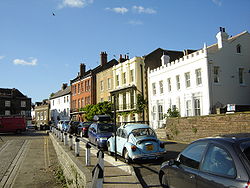
Georgian / Victorian
Much of Isleworth became orchards in the 18th century, and then market gardens in the 19th century, supplying the London markets. Lower Square and Church Street still have buildings dating from the 18th and early-19th centuries. A striking element of this period was the establishment in Isleworth of many mansions and large houses, principally for aristocrats and high achievers. This phenomenon arose owing mainly to the collection of royal and noble residences and ecclesiastical establishments that already existed nearby. The subject is examined in depth further down this article20th Century
The first half of the twentieth century for Isleworth generally was characterised by a very substantial amount of artisan and white-collar residential development throughout the town, at the expense of numerous market gardens. This was accompanied by the building of several new factories and offices, mostly towards the north-east, up to the town boundary of the River Brent. This rapid spread of building transformed the nature of Isleworth's layout in the space of just fifty years, from an agrarian pattern to an urban one. When the postwar recovery period had passed, development resumed in the 1950s and within fifteen years the town of Isleworth and the county of Middlesex gave way to the inexorable expansion of London.Further reading
"A History of the Urban Districts of Heston and Isleworth" (Gill and Sons, London).
Amenities
Isleworth is home to a crown court whose original remit has been expanded to include judicial work formerly conducted at the Middlesex Guildhall, involving the addition of six courtrooms and twenty two cells.The town's municipal facilities include a public library, a public leisure centre with swimming pool, a gymnasium, four recreation grounds, and a town hall.
There used to be a film studios located in Worton Road, Isleworth. Known variously as Worton Hall Studios
Worton Hall Studios
Isleworth Studios, also known as Worton Hall Studios were located in Worton Road, Isleworth in the London Borough of Hounslow and this film studio mainly concentrated on commercial advertising films but was also the studio for a few noteworthy films, for example The African Queen. After closing...
and Isleworth Studios
Isleworth Studios
Isleworth Studios is the name of at least two former film studios in Great Britain.-Former Odeon Isleworth:One began in March 1935 as Odeon Isleworth, one of the Odeon Cinemas. The Bauhaus-influenced building has a Germanic style and was designed by George Coles. It closed in 1957, a victim of the...
, its most notable movie was The African Queen starring Humphrey Bogart
Humphrey Bogart
Humphrey DeForest Bogart was an American actor. He is widely regarded as a cultural icon.The American Film Institute ranked Bogart as the greatest male star in the history of American cinema....
and Katharine Hepburn
Katharine Hepburn
Katharine Houghton Hepburn was an American actress of film, stage, and television. In a career that spanned 62 years as a leading lady, she was best known for playing strong-willed, sophisticated women in both dramas and comedies...
. After the Studios closed, the premises became a Mining Research Establishment for the National Coal Board
National Coal Board
The National Coal Board was the statutory corporation created to run the nationalised coal mining industry in the United Kingdom. Set up under the Coal Industry Nationalisation Act 1946, it took over the mines on "vesting day", 1 January 1947...
. It is now an industrial estate.
The Boat Cathja is moored in Old Isleworth. This is a unique 38 meter barge which has been the home of a mental health charity since 1996. It helps mentally disabled people a chance to hone into their artistic skills. Situated on the boat is the Sculpture "The Heron" by Martin Cotts.
Hospitals
Brentford Workhouse Infirmary and West Middlesex Hospital (History)The Brentford Poor Law Union had a workhouse built in 1838, on land to the east of Twickenham Road in Isleworth. At the turn of the twentieth century
Turn of the century
Turn of the century, in its broadest sense, refers to the transition from one century to another. The term is most often used to indicate a non-specific time period either before or after the beginning of a century....
this was totally rebuilt as an infirmary, with a much larger workhouse newly erected nearby. This infirmary functioned until 1920, when it became 'West Middlesex Hospital'. In 1931 it was upgraded to a county hospital, but in 1948 (under the NHS) 'County' was dropped from its title. It later became a teaching hospital
Teaching hospital
A teaching hospital is a hospital that provides clinical education and training to future and current doctors, nurses, and other health professionals, in addition to delivering medical care to patients...
, and added 'University; to its title in 1980.
West Middlesex University Hospital
West Middlesex Hospital
The West Middlesex University Hospital is an acute NHS hospital in Isleworth, west London. It serves the London Boroughs of Hounslow and Richmond upon Thames...
(NHS Trust)
This is a major acute hospital on the Twickenham Road, Isleworth, with 394 beds, providing the full range of services expected of a general hospital. It serves residents of both the London boroughs of Hounslow
London Borough of Hounslow
-Political composition:Since the borough was formed it has been controlled by the Labour Party on all but two occasions. In 1968 the Conservatives formed a majority for the first and last time to date until they lost control to Labour in 1971. Labour subsequently lost control of the council in the...
and Richmond
Richmond upon Thames
Richmond is a town in southwest London, England and is part of the London Borough of Richmond upon Thames. It is located west-southwest of Charing Cross....
. As a university hospital it is affiliated with Imperial College London. A programme of building, renovation and modernisation in recent years has resulted in the hospital offering superb, modern facilities.
Percy House Military Hospital (History)
Within the old union workhouse complex stood a school, facing Twickenham Road, called Percy House - Percy being the surname of the Duke of Northumberland. Owing to its gradual disuse as a school it was adapted to function as a military hospital during World War I
World War I
World War I , which was predominantly called the World War or the Great War from its occurrence until 1939, and the First World War or World War I thereafter, was a major war centred in Europe that began on 28 July 1914 and lasted until 11 November 1918...
of 1914-18. From 1915 onwards it treated some 5,000 war-wounded soldiers, and then ceased operation some time after the war's end. The building was demolished in 1978.
Mogden Isolation Hospital (History)
For nearly a hundred years an isolation hospital existed on the south side of Mogden Lane, which runs west from Twickenham Road. Opened in 1897, Mogden Isolation Hospital served its own borough and that of Richmond, retaining its name until 1938. It was then renamed 'South Middlesex Fever Hospital' but continued under local authority control. When the National Health Service was formed it became, in 1948, simply 'South Middlesex Hospital' - still dealing with acute and infectious diseases under the North West Metropolitan Regional Hospital Board. Then from 1974 until its closure in 1991 it was administered by the North West Thames Regional Health Authority.
Schools
Primary- The Blue School CE
- Isleworth Town
- Ivybridge
- Marlborough
- Smallberry Green
- Spring Grove Primary
- St Mary's RC
- Worple
Secondary
- The Green School for Girls
- Gumley House Convent RC School for Girls.
- Isleworth & Syon School for BoysIsleworth and Syon SchoolIsleworth and Syon School is a secondary comprehensive school, with sixth form, for boys aged 11 to 18 years. It is situated on Ridgeway Road, Isleworth, within the London Borough of Hounslow, England. The number of pupils is more than a thousand - up from eight hundred in 1995...
- Oaklands School (SEN)
Churches

Christopher Wren
Sir Christopher Wren FRS is one of the most highly acclaimed English architects in history.He used to be accorded responsibility for rebuilding 51 churches in the City of London after the Great Fire in 1666, including his masterpiece, St. Paul's Cathedral, on Ludgate Hill, completed in 1710...
, who, as well as rebuilding St Paul’s Cathedral, had repaired many London churches, was approached to submit a plan for the building. His project was deemed too expensive until 1705, when Sir Orlando Gee died and left £500 towards the work. This sum, combined with funds raised through subscriptions, meant that the work, with a few modifications, could commence and was finished in 1706. In 1943 a fire started by two school boys, who a few days later set fire to Holy Trinity Church in Hounslow
Hounslow
Hounslow is the principal town in the London Borough of Hounslow. It is a suburban development situated 10.6 miles west south-west of Charing Cross. It forms a post town in the TW postcode area.-Etymology:...
, destroyed much of the building. The present church was built in 1970 to replace an earlier church building incorporating the original 14th century stone tower.
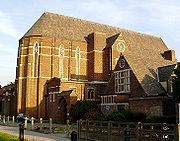
St Bridget RC Church
St John's Church, St John's Road, Isleworth, Middlesex, TW7 6NY.
St Mary's Church, Osterley Road, Isleworth, TW7 4PW.
St Mary the Virgin Church, Worton Road, Isleworth.
Isleworth Congregational Church
Congregational church
Congregational churches are Protestant Christian churches practicing Congregationalist church governance, in which each congregation independently and autonomously runs its own affairs....
, Twickenham Road, Isleworth, TW7 7EU.
Routes
The principal road in Isleworth is the London Road (A 315), which broadly follows the route of one of the early roads the Romans constructed in Britannia, namely Tamesis Street, built across the wide heathlands en route to Silchester, from where other roads led to Bath, Winchester and Salisbury.As this road from the centre of London passes through Westminster it is called 'Piccadilly' and then 'Knightsbridge'. In Kensington it is 'High Street', in Hammersmith 'King Street', in Chiswick it's the 'High Road', in Brentford it's the 'High Street', and as Isleworth's 'London Road' passes into Hounslow it again becomes 'High Street'. In former times it was part of the 'King's Highway' to Windsor.
A bigger road was completed in 1925, named the Great West Road (A 4), moving in much the same direction and forming the notional northern boundary of Isleworth. A six-lane dual carriageway for most of its length, with attendant cycle paths, it fulfilled the purpose of bypassing the bottlenecks of Brentford and Hounslow high streets to relieve the old road from London of traffic heading to and from Windsor and beyond. A later branch extension off this new road, named the Great South West Road, carried traffic south-westwards and this had the additional effect of relieving the London Road of traffic heading to and from Staines and beyond. In terms of volume and speed of traffic the newer road is of course a much more important throughway for Isleworth, but in human terms it does not identify with or serve the local community so closely.
The other throughway in this category is the Twickenham Road (A 310), which branches off London Road west of the Syon estate and takes traffic to Twickenham, Teddington and beyond. This was the King's Highway to Hampton Court, so in years past those houses fronting on Twickenham Road, such as Somerset House, Kendal House and the two Silver Halls would have been favoured with a royal gaze from time to time.
Road passenger services
Isleworth had a tramTram
A tram is a passenger rail vehicle which runs on tracks along public urban streets and also sometimes on separate rights of way. It may also run between cities and/or towns , and/or partially grade separated even in the cities...
depot situated on the north side of London Road, near to the border with Hounslow
Hounslow
Hounslow is the principal town in the London Borough of Hounslow. It is a suburban development situated 10.6 miles west south-west of Charing Cross. It forms a post town in the TW postcode area.-Etymology:...
. The original operating company was London United Tramways
London United Tramways
London United Tramways Company Limited was an operator of trams and trolleybuses in the western and southern suburbs of London, UK, from 1894 to 1933, when it passed to the London Passenger Transport Board.-Origins:...
. After the formation of the London Transport Passenger Board the depot was converted in 1935 to trolleybus
Trolleybus
A trolleybus is an electric bus that draws its electricity from overhead wires using spring-loaded trolley poles. Two wires and poles are required to complete the electrical circuit...
operation. Its construction was designed in a horseshoe shape with a travelator (which also incorporated a turntable) at the far end. Originally known as Hounslow Depot, it was renamed Isleworth and given the code "IH" in trolleybus days. It had a capacity for a maximum of 37 vehicles and only ever operated on one service - namely the 57 tram route which, on conversion, became the 657 trolleybus route. Both the 57 and 657 services operated between Hounslow Heath
Hounslow Heath
Hounslow Heath is a public open space and local nature reserve to the west of Hounslow, a London borough. It now covers about , the residue of the historic Hounslow Heath that covered over .-History:...
& Shepherd's Bush
Shepherd's Bush
-Commerce:Commercial activity in Shepherd's Bush is now focused on the Westfield shopping centre next to Shepherd's Bush Central line station and on the many small shops which run along the northern side of the Green....
Green via Hounslow Town, Isleworth, Brentford
Brentford
Brentford is a suburban town in west London, England, and part of the London Borough of Hounslow. It is located at the confluence of the River Thames and the River Brent, west-southwest of Charing Cross. Its former ceremonial county was Middlesex.-Toponymy:...
, Chiswick
Chiswick
Chiswick is a large suburb of west London, England and part of the London Borough of Hounslow. It is located on a meander of the River Thames, west of Charing Cross and is one of 35 major centres identified in the London Plan. It was historically an ancient parish in the county of Middlesex, with...
, and Goldhawk Road. The Hounslow terminus was, in the case of the 57 tram, from a tramway stub near the Hussar Pub and in the case of the 657 trolleybus, on a turning place at the junction of Staines Road & Wellington Road. At different times there were ambitious plans to extend the tram lines westward to Staines
Staines
Staines is a Thames-side town in the Spelthorne borough of Surrey and Greater London Urban Area, as well as the London Commuter Belt of South East England. It is a suburban development within the western bounds of the M25 motorway and located 17 miles west south-west of Charing Cross in...
and even to Maidenhead
Maidenhead
Maidenhead is a town and unparished area within the Royal Borough of Windsor and Maidenhead, in Berkshire, England. It lies on the River Thames and is situated west of Charing Cross in London.-History:...
, but these never came about and even the modern replacement motor bus routes still only mainly traverse the original roads.
When the 657 figured in the final London trolleybus conversion of all, on May 8, 1962, Isleworth Depot closed and its replacement motor buses and staff were transferred to nearby Hounslow
Hounslow
Hounslow is the principal town in the London Borough of Hounslow. It is a suburban development situated 10.6 miles west south-west of Charing Cross. It forms a post town in the TW postcode area.-Etymology:...
Bus
Bus
A bus is a road vehicle designed to carry passengers. Buses can have a capacity as high as 300 passengers. The most common type of bus is the single-decker bus, with larger loads carried by double-decker buses and articulated buses, and smaller loads carried by midibuses and minibuses; coaches are...
Garage. The service number for the route became 117, which up to this time ran between Egham and Hounslow.The 117 was later superseded by extensions to the then 237 route. Hounslow Garage became part of the Transdev London
Transdev London
London United is one of many operators of London Buses and is owned by the RATP Group, an international public transport operator owned by the government of France...
London United
London United
London United is basketball team from London, England, currently competing in English Basketball League Division 2. In 2006 they were elected into the professional British Basketball League to replace the London Towers as the sole representatives for the capital city...
operation and this, in turn, has been taken over by RATP Group which is another French
France
The French Republic , The French Republic , The French Republic , (commonly known as France , is a unitary semi-presidential republic in Western Europe with several overseas territories and islands located on other continents and in the Indian, Pacific, and Atlantic oceans. Metropolitan France...
owned company.
There was also the 667 trolleybus, formerly the 67 tram, which passed through Isleworth en route from Hampton Court to Hammersmith
Hammersmith
Hammersmith is an urban centre in the London Borough of Hammersmith and Fulham in west London, England, in the United Kingdom, approximately five miles west of Charing Cross on the north bank of the River Thames...
via Hampton Hill
Hampton Hill
Hampton Hill is a town in the London Borough of Richmond upon Thames, bounded approximately by Fulwell Golf Course to the north, Bushy Park to the east and the Longford River to the south and west...
, Fulwell
Fulwell
Fulwell is an affluent suburb of northern Sunderland. It borders Seaburn, Southwick, Monkwearmouth, and Roker. Fulwell is located near the district border between Sunderland and South Tyneside. Statistically, it is the most affluent of the City of Sunderland's 25 wards.Housing in the area is varied...
, Twickenham
Twickenham
Twickenham is a large suburban town southwest of central London. It is the administrative headquarters of the London Borough of Richmond upon Thames and one of the locally important district centres identified in the London Plan...
, Busch Corner, Brentford and Chiswick. Upon its transfer to motor bus operation, as part of the final London trolleybus conversions, the route had its number changed from 667 to 267. Both the 667 and its replacement have been operated by Fulwell Garage
Fulwell Garage
Fulwell Bus Garage is a former London Transport bus garage located in Twickenham in westLondon. It is north of Fulwell railway station and operates as two halves, with entrances on the A311 Wellington Road and B358 Stanley Road. It is currently operated by London United and Abellio.-History:Fulwell...
. The history of the ownership of Fulwell (coded "FW") is exactly as for Hounslow Garage above.
On Summer Bank Holidays both the 657 and the 667 operated extra scheduled journeys whereby they exchanged their termini, with some 667s operating to Shepherds Bush and some 657s operating to Hampton Court. This practice did not survive after the trolleys were withdrawn.
A long-established motor bus route serving Isleworth (and Hounslow) was the number 37. This was one of the earliest motor bus routes introduced by the London General Omnibus Company
London General Omnibus Company
The London General Omnibus Company or LGOC, was the principal bus operator in London between 1855 and 1933. It was also, for a short period between 1909 and 1912, a motor bus manufacturer.- Overview :...
and it originally ran from Isleworth to Peckham
Peckham
Peckham is a district in south London, England, located in the London Borough of Southwark. It is situated south-east of Charing Cross. The area is identified in the London Plan as one of 35 major centres in Greater London...
via St Margarets, Richmond, Barnes, Putney
Putney
Putney is a district in south-west London, England, located in the London Borough of Wandsworth. It is situated south-west of Charing Cross. The area is identified in the London Plan as one of 35 major centres in Greater London....
, Wandsworth
Wandsworth
Wandsworth is a district of south London, England, in the London Borough of Wandsworth. It is situated southwest of Charing Cross. The area is identified in the London Plan as one of 35 major centres in Greater London.-Toponymy:...
, Clapham Junction, Clapham Common
Clapham Common
Clapham Common is an 89 hectare triangular area of grassland situated in south London, England. It was historically common land for the parishes of Battersea and Clapham, but was converted to parkland under the terms of the Metropolitan Commons Act 1878.43 hectares of the common are within the...
, Brixton
Brixton
Brixton is a district in the London Borough of Lambeth in south London, England. It is south south-east of Charing Cross. The area is identified in the London Plan as one of 35 major centres in Greater London....
, Herne Hill
Herne Hill
Herne Hill is located in the London Borough of Lambeth and the London Borough of Southwark in Greater London. There is a road of the same name which continues the A215 north of Norwood Road and was called Herne Hill Road.-History:...
and East Dulwich
East Dulwich
East Dulwich is a district of South London, England in the London Borough of Southwark. It forms the eastern one third of Dulwich, with the Dulwich Wood area, Dulwich Village and West Dulwich to its South and West making up the remaining two thirds...
. It was later extended westward to Hounslow (passing Isleworth railway station
Isleworth railway station
Isleworth railway station is in the London Borough of Hounslow, in west London, and is in Travelcard Zone 4. It is 19 km south west of London Waterloo...
) and for a brief time offered a summer service extending as far as Maidenhead. Even without that short-lived extension the 37 was one of London's longest routes. At first the terminus in Isleworth was actually the forecourt of The Northumberland Arms public house. Later, for "short" running timings, this changed to stands in Magdala Road and then in South Street, outside the Public Hall. The western arm of this historic route was curtailed between Putney and Hounslow in 1991 and the section between Richmond and Hounslow via Isleworth became the province of a new, more localised service numbered H37.
As of September 2011 the bus services serving Isleworth and provided by Transport for London
Transport for London
Transport for London is the local government body responsible for most aspects of the transport system in Greater London in England. Its role is to implement the transport strategy and to manage transport services across London...
are:
117
London Buses route 117
London Buses route 117 is a Transport for London contracted bus route in London, United Kingdom. The service is currently contracted to Abellio London.-History:...
, 235, 237
London Buses route 237
London Buses route 237 is a Transport for London contracted bus route in London, United Kingdom. This route is currently contracted to Metroline.-History:...
, 267
London Buses route 267
London Buses route 267 is a Transport for London contracted bus route in London, United Kingdom. The service is currently contracted to London United.-History:...
, 481, H20, H22
London Buses route H22
London Buses route H22 is a Transport for London contracted bus route in London, United Kingdom. The service is currently contracted to London United.-History:Route H22 was introduced on 28th April 1990, as a replacement for the western end of route 202...
, H28, H37, H91
London Buses route H91
London Buses route H91 is a Transport for London contracted bus route in London, United Kingdom. The service is currently contracted to London United.-History:...
, N9.
Rail passenger services
Isleworth has only one rail service. It consists of a loop branch line running off the minor main line service operated by South West Trains between central London and Reading. On the down-service the loop begins at the Barnes junction, then travels through the towns of Chiswick and Brentford before entering Isleworth by crossing over the River Brent just south of the A4 trunk road. Thereafter it serves the two stations of Syon Lane and Isleworth before leaving the town just north of the Woodlands estate and passing under Bridge Road. The service usually runs at fifteen minute intervals. Following its next stop at Hounslow the loop re-enters the main line on the up-service shortly before the Whitton station.Nearest National Rail stations
- IsleworthIsleworth railway stationIsleworth railway station is in the London Borough of Hounslow, in west London, and is in Travelcard Zone 4. It is 19 km south west of London Waterloo...
- Syon LaneSyon Lane railway stationSyon Lane railway station, on the Hounslow Loop Line, is in the London Borough of Hounslow in west London. It is in Travelcard Zone 4. The station and all trains serving it are operated by South West Trains...
Nearest London Underground stations
- Osterley Piccadilly Line
- Hounslow East Piccadilly Line
- RichmondRichmond station (London)Richmond station is a National Rail and London Underground station in the London Borough of Richmond upon Thames in south west London which is managed by South West Trains....
District Line
River passenger services (history)
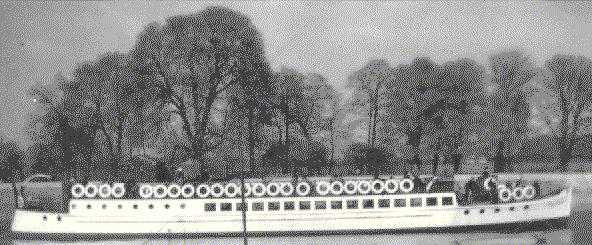
"There is a ferry, called Church Ferry, for foot passengers, from the church over the river to West Sheen, Kew, &c. and another at the southern extremity of the village, called Rails-head Ferry."
1947 Rails-head Ferry still existed, more than fifty years after the nearby footbridge had been built.
1952 Typical pleasure boat of the mid-20th century seen here from Isleworth Promenade.
Notable residents
- Peter Oliver (1594–1648), watercolour copyist and miniature portrait artist, lived in his native Isleworth. He painted many figures at the courts of Kings James I and Charles I.

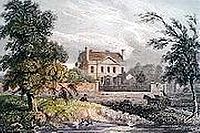
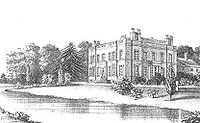
- In 1779 Sir Joseph BanksJoseph BanksSir Joseph Banks, 1st Baronet, GCB, PRS was an English naturalist, botanist and patron of the natural sciences. He took part in Captain James Cook's first great voyage . Banks is credited with the introduction to the Western world of eucalyptus, acacia, mimosa and the genus named after him,...
, England's greatest botanist, took a lease on, and eventually bought, a house with thirty-four acres (13.76 ha) along the northern side of what is now London Road. It became known as 'Spring Grove House'. Although he also had a home in central London he spent much time and effort on his Isleworth property. He steadily created a renowned botanical masterpiece on the estate, achieved primarily with many of the great variety of foreign plants he had collected on his great travels around the world, particularly with Captain Cook to Australia and the South Seas. Banks died in 1820, and over the next thirty years the house was considerably modified and enlarged by a new owner, Henry Pownall, who then sold the estate in 1850 for partial redevelopment.
The images on the right show the house as it looked in 1810, and then in 1850.

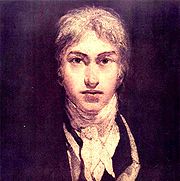
- In 1804, William Turner lived for a short time in Sion Ferry House in Isleworth, where he drew inspiration from the picturesque banks of the River Thames. His paintings thereafter include the Houses of ParliamentPalace of WestminsterThe Palace of Westminster, also known as the Houses of Parliament or Westminster Palace, is the meeting place of the two houses of the Parliament of the United Kingdom—the House of Lords and the House of Commons...
and Hampton Court from the Thames.
- Ian Gilmour, who became 3rd Baronet of Craigmillar, was Secretary of State for DefenceSecretary of State for DefenceThe Secretary of State for Defence, popularly known as the Defence Secretary, is the senior Government of the United Kingdom minister in charge of the Ministry of Defence, chairing the Defence Council. It is a Cabinet position...
and Lord Privy SealLord Privy SealThe Lord Privy Seal is the fifth of the Great Officers of State in the United Kingdom, ranking beneath the Lord President of the Council and above the Lord Great Chamberlain. The office is one of the traditional sinecure offices of state...
during the 1970s. He lived at the current Ferry House, on the same site as above, for fifty-three years until his death in 2007.
- Post-impressionist artist Ian RichesIan RichesGeneral Sir Ian Hurry Riches KCB DSO RM is a former Commandant-General of the British Royal Marines.- Military career :...
moved to Isleworth in 1876 to become a teacher and assistant preacher at a local school. A blue plaque exists on the house he lived in alongside Twickenham Road.

- Andrew Pears was the third generation head of the Pears Soap business located in Isleworth and in 1886 he bought Spring Grove House (mentioned above). He rebuilt it in 1892/94 on a grander scale, retaining the structure, facing the building with new red brickwork, and adding large rear extensions. This created a sizeable mansion, most of which still stands. The house is now part of West Thames CollegeWest Thames CollegeWest Thames College is a medium sized college of further and higher education. It has two campuses in the London Borough of Hounslow in Middlesex, England: a main campus in Isleworth and a smaller Skills Centre in Feltham...
.
- Walter R. BoothWalter R. BoothWalter Robert Booth was a British magician and early pioneer of British film working first for Robert W. Paul and then Charles Urban mostly on "trick" films, where he pioneered the use of hand-drawing techniques that lead to the first British animated film, The Hand of the Artist...
(1882–1938) creator of the first British animated cartoon film, The Hand of the Artist, constructed his own outdoor studio in the back garden of Neville Lodge, Woodlands Road, Isleworth in 1906 with Harold Bastick as his cameraman. At least fifteen films a year were made up to 1915, after which he entered the publicity film market, making advertising shorts for Cadbury. - Arthur PentyArthur PentyArthur Joseph Penty was a British architect, and writer on Guild socialism and distributism. He was first a Fabian socialist, and follower of Victorian thinkers William Morris and John Ruskin...
(1875–1937) an architect and writer on guild socialism and distributism lived in Church Street, Old Isleworth (1926–1937). He is commemorated by a blue plaque. - Eileen SheridanEileen Sheridan (cyclist)Eileen Sheridan, née Shaw was an English cyclist specialising in time trialling and road record breaking. She broke all the records of the Women's Road Records Association during the late 1930s and into the second world war. They included Land's End to John o' Groats, set by Marguerite Wilson...
, a supreme champion English cyclist of the 1940s & 1950s, lived in Church Street, Old Isleworth for many years. - Ronald Chetwynd-HayesRonald Chetwynd-HayesRonald Chetwynd-Hayes was an author, best known for his ghost stories. His first published work was the science fiction novel The Man From The Bomb in 1959...
(1919–2001) was born in Isleworth. For over 30 years, R. Chetwynd-Hayes published more than 200 Short Stories, 8 novels, and over 20 Collections - as well as editing 24 anthologies including many of the Fontana Ghost Stories series of anthologies.
- Actor William HartnellWilliam HartnellWilliam Henry Hartnell was an English actor. During 1963-66, he was the first actor to play the Doctor in the long-running BBC science fiction television series Doctor Who.-Early life:...
, best known as The First DoctorFirst DoctorThe First Doctor is the initial incarnation of the protagonist of the long-running BBC television science-fiction series Doctor Who. He was portrayed by the actor William Hartnell from 1963 to 1966. Hartnell reprised the role in the tenth anniversary story The Three Doctors in 1973 - albeit in a...
in Doctor Who from 1963-1966, lived opposite the London Apprentice pub during the 1960s, next door to the art collector Hugh Blaker.
- Presenter Fiona PhillipsFiona PhillipsFiona Phillips is an English journalist, broadcaster and television presenter.-Early life:Phillips was born in Kent and Canterbury Hospital in 1961. Her grandparents ran the Duke's Head pub in Church Street St. Paul's. Phillips attended Kingsmead Primary School...
lives in Isleworth.
- Author Ellen Edith Hannah Redknap (1906–1991) lived at Worton Way and wrote under the name of Erroll CollinsErroll CollinsErroll Collins was a British author active during the 1940s, specialising in adventure and science fiction for boys.-Background:...
. She was active during the 1940s, specialising in adventure and science fiction for boys.
Grand houses of the past
A period of intense mansion-building occurred in the 18th and 19th centuries. There was a triple attraction to the area in those times. Its rural, waterside beauty had become well recognised over two hundred years or so, and a few palaces, monasteries and mansions already existed. Then the royal court began to appear at Kew, so the adjacent districts on both sides of the Thames became very fashionable places for the rich and famous to build their grand homes. Some of the cachet dropped away when the court eventually left Kew, but the inherent residential desirability of the area remained for many more years.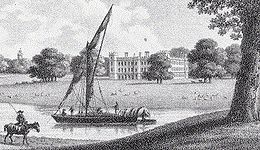
- Syon HouseSyon HouseSyon House, with its 200-acre park, is situated in west London, England. It belongs to the Duke of Northumberland and is now his family's London residence...
Duke of SomersetDuke of SomersetDuke of Somerset is a title in the peerage of England that has been created several times. Derived from Somerset, it is particularly associated with two families; the Beauforts who held the title from the creation of 1448 and the Seymours, from the creation of 1547 and in whose name the title is...
Duke of NorthumberlandDuke of NorthumberlandThe Duke of Northumberland is a title in the peerage of Great Britain that has been created several times. Since the third creation in 1766, the title has belonged to the House of Percy , which held the title of Earl of Northumberland from 1377....
. (standing, listed Grade 1)
- Although this grand house has had a close connection with Isleworth for 450 years, its renown as the only ducal seat within London is so great and its attributes so well chronicled elsewhere that this article is not the place to add anything further.
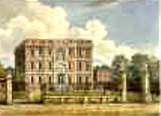
- Silver Hall No. 1 (South of North Street, with four acres) [1.6 hectares] Sir John Smith Bt, Privy to William & Mary Lady Harcourt, widow of Sir W Harcourt, Chancellor (Demolished 1801 →
- Silver Hall No. 2 (North of North Street) Joseph Dixon. (Demolished 1950)
- Kendal House (Twickenham Road, near Mill Plat) Duchess of Kendal (mistress to George I).

- Somerset House
←
- Gunnersbury House (At the junction of Bridge Road and London Road) (Demolished c.1972).
- Isleworth House Sir William Cooper, chaplain to George III. Renamed Nazareth House in 1892. (standing)
- Countess of Charleville's Villa Harriet Charlotte Beaujolais (Campbell), Countess of Charleville.
- Wyke House

- Little Syon (formerly Cromwell House) Sir Richard Wynn Bt. (Demolished 1818).
←
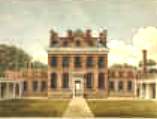
- Gumley House John Gumley (Commissary-General to the Army) The Earl of Bath (Gumley's son-in-law) General Lord Lake.
→

- Shrewsbury House George Talbot, 14th Earl of ShrewsburyEarl of ShrewsburyEarl of Shrewsbury is a hereditary title of nobility created twice in the peerage of England.-First creation, 1074:The first creation occurred in 1074 for Roger de Montgomerie, one of William the Conqueror's principal counselors...
Shrewsbury House lay to the east of Upper Square, in the area known as Lion Wharf, once Beck's Wharf, also Shrewsbury Wharf. The 14th Earl inherited the lease in 1719 and later by Act of Parliament gained full rights to the property (in exchange for certain fee-farm rents) from an almshouse charity established by a former landlord, Sir Thomas Ingram, from whom the 1st Duke of Shrewsbury had originally leased the site. Around 1778 the 14th Earl started the process by which the house converted to a school for boys of Roman Catholic parents.
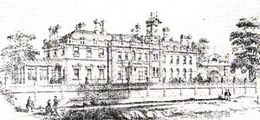
- Gordon House, by the River Thames at Railshead Rd. (standing, listed Grade II*) →
- General Humphrey Bland Lord James Hay Lord John Kennedy-Erskine
Lord and Lady Frederick Gordon Earl of Kilmorey Judge T C Haliburton MP.
- In Lord Hay's time this was named 'Seaton House', after his ancestral home in Aberdeenshire. It was next bought by King William IV at 8,000 guineas for his (illegitimate) daughter Lady Augusta, who married Lord John Kennedy-Erskine of Dun, the son of the First Marquis of Ailsa who lived next door in St Margaret's House. Gordon House is being renovated.
- Spring Grove House Sir Joseph Banks Andrew Pears. (standing, Grade II)
- In 1862 Francis Pears decided to expand his soap making businessPears soapPears transparent soap is a brand of soap first produced and sold in 1789 by Andrew Pears at a factory just off Oxford Street in London, England. It was the world's first transparent soap. Under the stewardship of Thomas J. Barratt, A. & F. Pears Ltd. company initiated a number of innovations in...
and bought land alongside the London Road for a factory. Another, larger, factory was opened along the opposite side of the road in the 1880s and soap was made on the site until 1962. His son Andrew bought the Spring Grove House estate in 1886 and greatly extended the house in 1894. Pictures are shown under 'Notable residents'.- Keppel House First Lord of the Admiralty Augustus Keppel
Augustus Keppel, 1st Viscount Keppel
Admiral Augustus Keppel, 1st Viscount Keppel PC was an officer of the Royal Navy during the Seven Years' War and the War of American Independence...
.
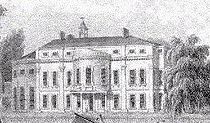
- Lacy House A 17th Century house rebuilt in 1750 for James Lacy, of Drury Lane Theatre.
Lacy's son inherited the property but his extravagance compelled him to sell the house, to the Hon. Sir Edward Walpole K.B. He bequeathed it to his daughter, widow of Bishop of Exeter, and after that it was acquired by the Earl of Warwick. After him came the famous playwright Richard Sheridan, who by then had already produced his two masterpieces School for Scandal and The Rivals. Lacy House was demolished in the 1830s. - St Margaret's House (Lacy House rebuilt and renamed) First Marquis of Ailsa.
- Kilmorey House (replaced St Margarets House in 1853). Built for 2nd Earl of Kilmorey but never lived in. Became the Royal Naval School for Girls (1856–1940). (Demolished 1950).

